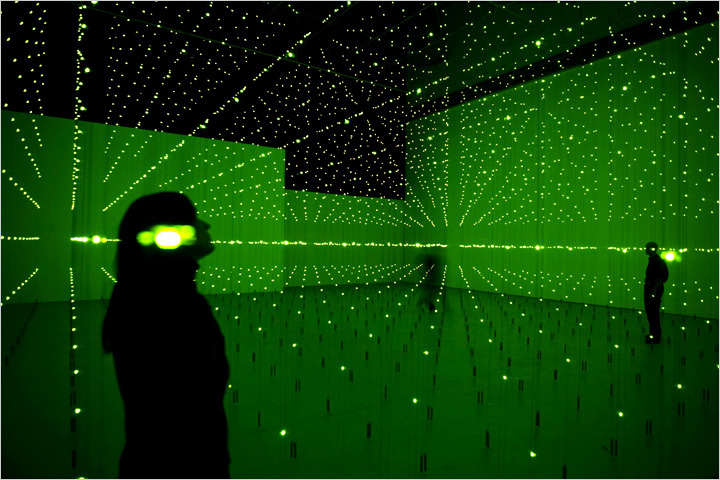Installation by Kathy Hinde
The inside of an old upright piano, rescued from destruction, is transformed into a kinetic sound sculpture. Video projections move across the surface of the piano strings, triggering small machines to twitch and flutter causing the strings to resonate. The video is visually akin to a musical score or piano roll, and this installation can also become the site for a live performance.
The video is analysed by a MaxMSP patch which divides the screen into a 5×5 grid to correspond to the motors and solenoids which are also arranged in a 5×5 grid on the piano. Movement or any change sensed in the video triggers a device in the corresponding square of the grid – the result is that the fluttering and movement of a bird triggers a device closest to it on the piano.
MaxMSP programming by Matthew Olden
Commissioned by Lumin, May 2010
Archivi categoria: Installationi
Sun Boxes
Sun Boxes is a sound installation created by Craig Colorusso.
It’s comprised of twenty speakers operating independently each powered by solar panels. There is a different guitar sample in each box all playing together making the composition. The guitar samples are all of different lengths so the whole piece keeps evolving.
Participants are encouraged to walk amongst the speakers. It sounds different inside of the array. There is a different sense of space inside. Certain speakers will be closer and louder therefore the piece will sound different to different people in different positions throughout the array. Creating a unique experience for everyone.
There are no batteries involved. The Sun Boxes are reliant on the sun. When the sun sets the music stops. The piece changes as the length of the day changes making the participants aware of the cycle of the day.
It’s a very interesting idea. I would like to know how powerful each speaker is. 5 Watt? 10?
Playing the building
Playing the Building is a sonic project by ex-Talking Head David Byrne that came to London in 2009. You could sit down at an “antique organ” and hit whatever keys or chords your heart desired—but you wouldn’t be producing notes.
You would instead trigger a “series of devices,” as Byrne describes them: hammers and dampers distributed throughout the building in which you sat. Distant windowpanes and metal cross-beams, hooked up to wires, would begin to vibrate, tap, and gong. Imagine someone like this sitting in the darkness beneath Manhattan, causing haunted musics and unexplained knocks inside rooms and abandoned buildings around the city. Now, even urban infrastructure will be musicalized.
The Ocean of Light
The Ocean of Light project explores the creative and immersive possibilities of light-based visualisation in physical space. It uses bespoke hardware to create dynamic, interactive and three-dimensional sculptures from light.
Surface is the first artwork to be exhibited using the Ocean of Light hardware. It uses minimal visuals and sound to evoke the essence of character and movement. Autonomous entities engage in a playful dance, negotiating the material properties of a fluid surface.
The Ocean of Light project is a collaborative research venture, led by Squidsoup and supported by the Technology Strategy Board (UK). Partners include Excled Ltd and De Montfort University. Additional support and resources have been provided by Oslo School of Architecture and Design (Norway), Massey University, Wellington (New Zealand) and Centre for Electronic Media Art, Monash University (Aus).
Squidsoup is a digital arts group specialising in immersive interactive installations within physical 3D space. Their work combines sound, light, physical space and virtual worlds to produce immersive and emotive headspaces. They explore the modes and effects of interactivity, looking to make digital experiences where meaningful and creative interaction can occur.
Fibonacci in Turku
Incredibilmente in Turku (Finlandia) esiste una ciminiera con sopra parte della serie di Fibonacci (cliccate sull’immagine) che, di notte, è illuminata e splende nel buio come l’unica cosa visibile (o quasi).
Si tratta, in realtà di una installazione di Mario Mertz del 1997, il cui titolo è “Fibonacci Sequence 1-55” e il sottotitolo “Metafora della ricerca dell’uomo di ordine e armonia nel caos”.
LEDs
Austrian-born artist Erwin Redl uses LEDs as an artistic medium. Working in both two and three dimensions, his works redefine interior and exterior spaces. Born in 1963, Redl began his studies as a musician, receiving a BA in Composition and Diploma in Electronic Music at the Music Academy in Vienna, Austria. In 1995, he received an MFA in Computer Art at the School of Visual Arts in New York, where he now lives.
Redl’s works have received attention both nationally and internationally. With his piece Matrix VI (detail), he lit the face of New York’s Whitney Museum of American Art for its 2002 Biennial Exhibit. Works such as Matrix II, which was shown in New York, Germany, France, Austria, and Korea, and Fade I, which animated the Eglise Sainte-Marie Madeleine in Lille, France, explore volume and allow people to move through lit spaces.
Photos from “Ecstasy: In and About Altered States” (2005)


Light_Paper_Sound
Light_Paper_Sound è una installazione in cui dei video vengono proiettati su superfici tridimensionali di carta che in tal modo assumono varie colorazioni e sfumature che cambiano nel tempo. Nello stesso tempo delle tracce audio sono diffuse da altoparlanti.
This exhibition is an installation using randomly selected video projected on three dimensional paper surfaces synced with audio tracks played on speakers in the environment. The overall effect creates a unique environment of dynamic color and sound.
The works collaborators are artists Joseph Gray (sculpture/video) and Gabriel Herbertson (audio) with original music by Beth Fleenor (clarinet) and Paris Hurley (violin).


